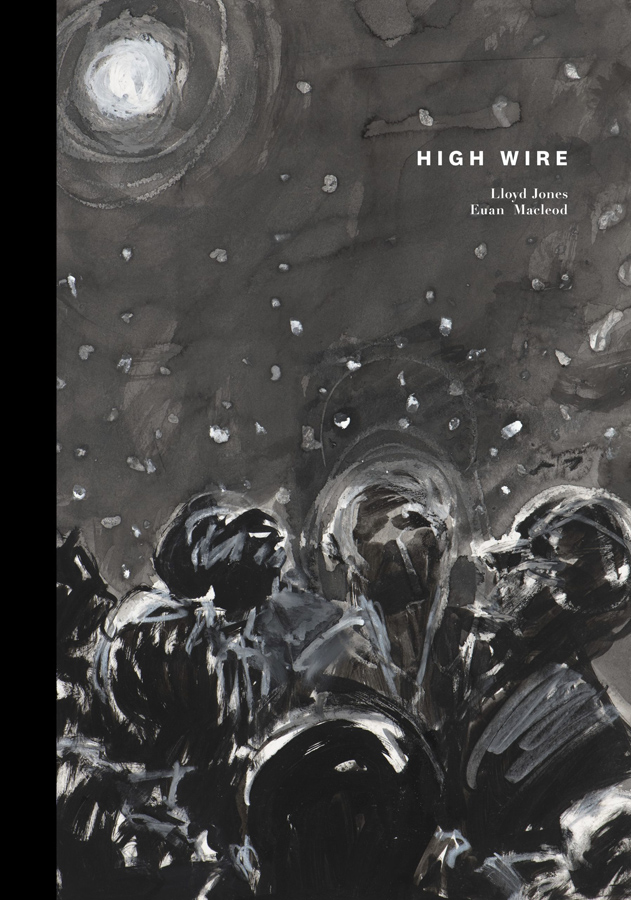High Wire is the first picture book in the kōrero series from Massey University Press. The endpaper credit announces this as inviting ‘new and exciting collaborations – for two different kinds of artistic intelligence to work away at a shared topic’. Here, the two collaborators are the writer Lloyd Jones and the artist Euan Macleod. I’d add the book designer Gary Stewart of The Gas Project (‘design and stuff’), a Central Otago-based design office with a remarkable books catalogue. The Jones/Macleod kōrero debut is an ambitious place to start and on the strength of this launch we can look forward to the series, which I hear on the grapevine will include a collaboration between the photographer Haru Sameshima and the writer Paula Morris, subject: Robin Hyde.
The Jones/Macleod book opens with a title page (HIGH WIRE) and moves to two vigorously sketched facing pages in which a figure with a beaky nose is supine on a line (a ‘high wire’?) with what might be clouds both above and below. Then comes a painted or ink-brushed page in which the figure is bent over on a sagging wire, its nose and the brush in its hand pointing down at a painting balanced on the wire. The painting is of a figure balanced on a wire, and the beaky-nosed one wielding a brush might be painting itself balancing on a wire – a feat at once daring in itself if ‘true’ but also a reflexive metaphor for the creative balancing act that we’re about to encounter.
The following page adds the names Lloyd Jones and Euan Macleod to ‘HIGH WIRE’ – a writer and an artist. Next we encounter the writer’s first page, and here the balancing act begins. This isn’t just between the collaborative shares of text and graphic languages, but of a concept stretched between an initial idea (‘a project about bridges’) and disillusionment with that idea (‘… a single life consisting of many bridges crossed, then re-crossed, one after another …’). Jones finds his ‘heady ideas’ collapsed by ‘the commonality of experience’. After two pages of drawings in which the tightrope walker is looking apprehensively behind itself while another is hanging from the wire, and on the next crawling precariously, Jones states simply that, ‘I was not where I thought I was. I was not alone. The art I looked for was not there.’ This is aloof attitude towards shared experience and audience (‘commonality of experience’) suggests that what Jones wants is an original – solo – act.
On the next page he, and we, find that act. It is Philippe Petit’s performance when, in 1974, ‘he steps out onto a wire linking the twin towers of the World Trade Centre.’ Cue a marvellous page by Macleod in which the beaky figure we now know to be the aerialist Petit is walking along a wire stretched through clouds, then two facing pages in which he seems to be walking at night among stars and a moon (below him), and next the slightly sagging wire above scumbled buildings with an aircraft flying past just above it. Jones’s text on the facing page confirms that, ‘There is a photo of him lying on the wire as a Boeing flies across the slot of sky above.’
At this point of tension between a solo act of individual daring and ‘commonality of experience’ – between high wire and bridge – Jones begins to rebalance his text. He had visited the Twin Towers ten years after Petit’s uniquely famous performance and, overcoming a fear of heights, had looked down from a top floor window and seen a small plane fly into low cloud below. In September 2001 he had seen the terrifying footage of people leaping from the burning towers. From this point on, Jones’s text – in effect a prose-poem – reverts to variations on the bridges concept dismissed at the outset as unoriginal. Only now, it’s as though the bridges – the childhood railway bridge crossed to reach the ‘chlorinated heaven’ of a swimming pool, the Brooklyn Bridge, the Sydney Harbour Bridge, the complex bridges (or not) of relationship, the bridge to nowhere, many others both literal and metaphorical – as though these and ‘what the world would look like if it were to abandon its bridges’ have been readmitted to Jones’s imagination and to the experience-sharing pages of this book, but enriched and revalued by the example of the tightrope-artiste Phillippe Petit.
The confidence with which both text and graphics move on from here is both adventurous and plain. Jones abandons his aloof hesitation and steps out across the wobbly bridges of experience. ‘I walked on, one steadying hand on the balustrade now, as another space opened up before me, a space where art is made.’ Or, in the case of his collaborator Macleod, a space shaped by ‘The struts and wires of his imagination.’
This review was originally published on the Academy of NZ Literature site.



